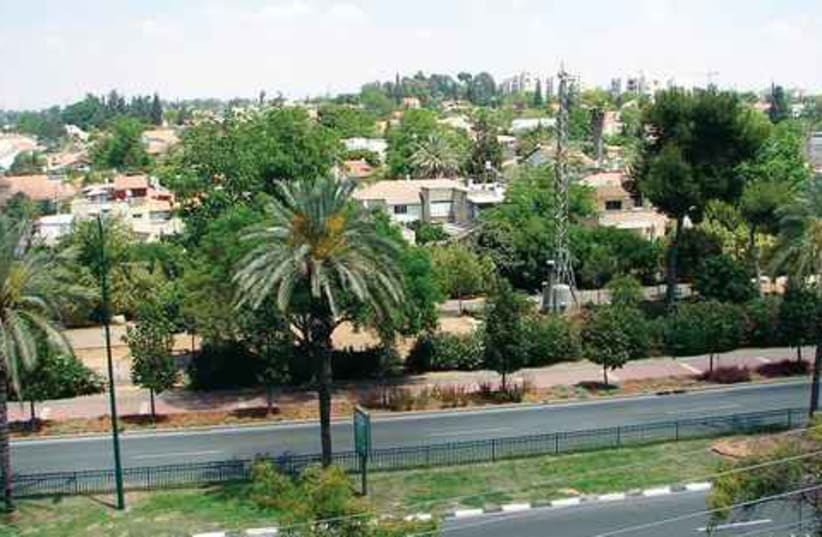Ha’argaman is one of the most modern neighborhoods in Ness Ziona, a town of around 50,000 inhabitants, situated between Rishon Lezion and Rehovot.Because of its proximity to the fastgrowing Rishon Lezion, Ness Ziona is undergoing a process of regulated development, of which Ha’argaman – which means “purple” – is a part.The town is one of the many that developed from the agricultural colonies established in Ottoman Palestine in the last quarter of the 19th country. Others include Petah Tikva and Hadera, which have developed into large cities.
When founded, Ness Ziona was one of a quintet in the area, including Rehovot, Mazkeret Batya, Gedera Rishon and of course, Rishon Lezion.Ness Ziona had exotic beginnings. It owes its existence to a German Templer named Reinhard Reisler. The Templer movement was Zionist but had Christian Lutheran tendencies, believing that settling Palestine with Christians would hasten the “Second Coming.” Yet Reisler was something of a loner. Instead of settling in one of the Templer colonies scattered all over Palestine, he chose to go it alone. He bought a plot of land in what is now the center of Ness Ziona – then called Wadi Hunayn – resettled his wife and five children, and started a farm.When his wife and children died of malaria, Reisler left Palestine and ended up in Odessa – today part of independent Ukraine, but then part of the Tsarist empire. It was there that he met Reuven Lehrer, a Zionist Jew who owned farmland in the Odessa area.Reisler, who had his fill of Palestine, and Lehrer, who wanted to go there soon, came to an agreement by which the former became the proud owner of rich agricultural land in the Ukraine, in return for his malaria-ridden land in Palestine.This was in 1882. By 1891, another Russian settler, Michael Halperin, had bought additional tracts of land in Wadi Hunayn and gathered a group of European Jews to settle them. Ness Ziona – the “standard [banner] to Zion” – was born.Until the War of Independence, Ness Ziona was a moshava – an agricultural village based on private ownership, as opposed to communal settlements like the socialist moshavim. In 1948, there were 4,446 inhabitants; by 1951, with the vast influx of immigrants that followed the state’s establishment, there were 9,000.NESS ZIONA can be roughly divided into two parts bisected by Route 412, which connects Rishon Lezion to Rehovot. The segment of that road in Ness Ziona is called Weizmann Street in honor of the country’s first president.The part of town west of Weizmann Street is considered more upscale than its eastern counterpart, and real-estate prices are on average 10 percent higher than in east Ness Ziona.One of the reasons for the relative popularity of west Ness Ziona is the modern apartment buildings, but there is also the proximity and relatively easy access to the Tel Aviv metropolitan area.In general, the price of real estate falls the further one gets from Tel Aviv. As such, the area is more expensive than Rehovot to the south, which is not as close to Tel Aviv.Another of the town’s selling points is that Ness Ziona is surrounded by hi-tech employment options: the Weizmann Institute of Science in Rehovot; an institute of advanced biology in Ness Ziona itself; and a large industrial park next to the Weizmann Institute but within the Ness Ziona municipal boundaries, that has been adapted to the needs of scienceoriented industries.Other than these, there are not many employment opportunities, and many Ness Ziona inhabitants commute to the employment centers of the Tel Aviv metropolitan area. Ness Ziona is now popular with families living in Tel Aviv and its first ring of satellite cities, who want to upgrade their living standards but cannot afford to do so in Tel Aviv, Givatayim or Ramat Gan. Prices in Ness Ziona are about half those of Tel Aviv.Another attraction is that development in Ness Ziona in general, and the western part in particular, is strictly regulated, and the municipality only issues building permits that do not alter the rural character of the city. In the central areas, no high-rise buildings are allowed, while in outlying areas such as Ha’argaman, the buildings are limited to seven or eight stories.Ha’argaman is in the western half of the city and is named after the purple iris, a protected wild flower that grows in the area. It covers an area of 220,000 square meters (approximately 55 acres).When completed, it will have over 1,060 dwellings – 1,000 apartments and 60 semi-detached dwellings.The neighborhood has a large commercial center next to the Argaman Park, which at 27,000 sq.m. is the largest public garden in the city.In Ha’argaman, a development company called Es Yud Even is building a seven-story, 12-unit residential block of extra-large apartments, which have an average price tag of NIS 1.8 million.In western Ness Ziona, a new four-room apartment costs NIS 1.6m. on average.An average new three-room apartment costs NIS 1.4m. A large five-room garden apartment can cost an average of NIS 2.3m., while a penthouse generally goes for NIS 3m.Among the developers working in Ha’argaman is the Yitzhaki Group, which has a project of 24 residential units in a seven-story residential building block called WOW, and the Sarfati development company, which is building a project called Sarfati on the Reserve – 182 residential units in eight seven-story buildings.Simon Haberkorn, the Ness Ziona concessionary of the Re/Max real estate brokerage network, tells Metro that “prices in Ness Ziona are creeping up. They have already overtaken average prices in neighboring Rishon Lezion and have long since overtaken prices in Rehovot.”According to Haberkorn, the city is “much in demand because the local government administration has made it a point to preserve as much as possible the moshava-like atmosphere of the city.Neighborhood Watch: Purple in Ness Ziona
Ness Ziona is undergoing a process of regulated development, of which Ha’argaman – which means “purple” – is a part.
